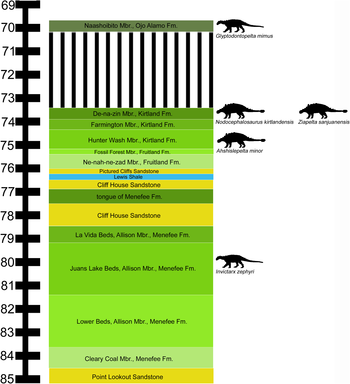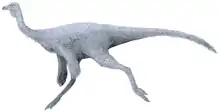Kirtland Formation
The Kirtland Formation (originally the Kirtland Shale) is a sedimentary geological formation.[1]
| Kirtland Formation Stratigraphic range: Campanian (typically Kirtlandian) 75–73 Ma | |
|---|---|
 | |
| Type | Geological formation |
| Sub-units | Hunter Wash, Farmington and De-na-zin Members |
| Underlies | Ojo Alamo Formation |
| Overlies | Fruitland Formation |
| Thickness | 594 m (1,949 ft) |
| Lithology | |
| Primary | Sandstone |
| Other | Shale, mudstone, conglomerate |
| Location | |
| Coordinates | 36.708°N 108.350°W |
| Approximate paleocoordinates | 42.6°N 76.3°W |
| Region | |
| Country | |
| Extent | San Juan Basin |
| Type section | |
| Named for | Kirtland Post Office |
| Named by | C.M. Bauer |
| Year defined | 1916 |
 Kirtland Formation (the United States)  Kirtland Formation (New Mexico) | |
Description
The Kirtland Formation is the product of alluvial muds and overbank sand deposits from the many channels draining the coastal plain that existed on the inland seashore of North America, in the late Cretaceous period. It overlies the Fruitland Formation. It is found in the San Juan Basin in the states of New Mexico and Colorado, in the United States of America.
The base of the Kirtland Formation and its lowest sub-unit, the Hunter Wash member, has been dated to 75.02 ± 0.13 Ma.[2] Together with the upper part of the underlying Fruitland Formation, this contains fossils representing the Hunter Wash local fauna. The border between the Hunter Wash member and overlying Farmington member dates to approximately 74 million years ago. The top of the Farmington member and bottom of the overlying De-na-zin member has been radiometrically dated to 73.37 ± 0.28 Ma ago. The top of the De-na-zin member, which contains the Willow Wash local fauna, has been dated to 73.04 ± 0.25 Ma ago.[1]
Overlying the De-na-zin member is a unit called the Naashoibito member This has often been considered to be part of the Kirtland formation, but more recently has been transferred back to the overlying Ojo Alamo Formation, which it had originally been part of.[1]
History of investigation
The formation was named by C.M. Bauer in 1916 for exposures near the Kirtland Post Office.[3]
Stratigraphy

Vertebrate paleofauna
Crurotarsans
| Crurotarsans of the Kirtland Formation | ||||||
|---|---|---|---|---|---|---|
| Genus | Species | Location | Member | Abundance | Notes | Images |
|
B. montana[4] |
|
Member of the Willow Wash local fauna.[4] |
| |||
|
D. kirtlandicus[4] |
|
Member of the Willow Wash local fauna.[4] |
||||
|
Indeterminate[5] |
|
Member of the Willow Wash local fauna.[4] |
||||
Ornithischians
| Ornithischians reported from the Kirtland Formation | ||||||
|---|---|---|---|---|---|---|
| Genus | Species | Location | Member | Material | Notes | Images |
|
A. minor[6] |
|
Incomplete postcranial skeleton[6] |
 Pentaceratops sternbergii | |||
|
A. horneri[7] |
"Partial skull."[7] |
|||||
|
K. navajovius[8] |
|
Member of the Willow Wash local fauna.[4] | ||||
|
N.ostromi[8] |
|
"Partial skull."[9] |
Member of the Willow Wash local fauna.[4] | |||
|
N. kirtlandensis[8] |
|
"Partial skull."[10] |
Member of the Willow Wash local fauna.[4] | |||
|
P. tubicen[8] |
|
"Disarticulated, associated skull and postcraniua, pertaining to at least [three] individuals."[11] |
Member of the Willow Wash local fauna.[4] | |||
|
P. fenestratus[8] |
||||||
|
P. sternbergi[8] |
More common in the lower part of the formation.[12] |
Member of the Willow Wash local fauna.[4] | ||||
|
S. goodwini[4] |
|
Member of the Willow Wash local fauna.[4] | ||||
|
S. novomexicanum[13] |
|
"SMP VP-2790, incomplete parietal"[13] |
Also found in the upper Fruitland Formation. | |||
|
T. sealeyi |
|
|||||
|
N. sullivani |
|
|||||
|
T. ouranos |
|
Member of the Willow Wash local fauna. Found to be a synonym of Pentaceratops sternbergii.[14] | ||||
|
Z. sanjuanensis |
Complete skull lacking the lower jaws, first two cervical half rings.[15] |
|||||
Pterosaurs
| Pterosaurs of the Kirtland Formation | ||||||
|---|---|---|---|---|---|---|
| Genus | Species | Location | Member | Abundance | Notes | |
|
N. boerei |
Partial phalanx and ulna fragment |
Hunter Wash Member |
||||
Saurischians
| Saurischians of the Kirtland Formation | ||||||
|---|---|---|---|---|---|---|
| Genus | Species | Location | Member | Abundance | Notes | Images |
|
A. sanjuanensis[17] |
Erroneously identified as a member of the Willow Wash fauna, specimens actually from the Naashoibito member of the Ojo Alamo Formation[18] |
| ||||
|
A. mirandus[19] |
Remains once attributed to the dubious tooth genus Aublysodon (and later Daspletosaurus)[19] are now referred to Bistahieversor, although these remains (OMNH 10131) may possibly have come from the Fruitland Formation.[20] | |||||
|
B. sealeyi[21] |
||||||
|
Unnamed[19] |
Remains formerly referred to an unidentified or undescribed species of Daspletosaurus were originally attributed to the dubious tooth genus Aublysodon.[19] These remains were later reclassified as belonging to the new genus Bistahieversor. Some of these remains (OMNH 10131), however, may have originated in the Fruitland Formation.[20] | |||||
|
O. sp.[8] |
|
Member of the Willow Wash local fauna.[4] | ||||
|
S. sullivani[22] |
|
|||||
|
"S." robustus[23] |
|
Member of the Willow Wash local fauna.[4] Originally assigned to Saurornitholestes, actually a troodontid.[24] | ||||
|
Indeterminate[25] |
||||||
Turtles
| Turtles of the Kirtland Formation | ||||||
|---|---|---|---|---|---|---|
| Genus | Species | Location | Member | Abundance | Notes | |
|
B. nobilis[4] |
|
Member of the Willow Wash local fauna.[4] | ||||
|
D. nodosa[4] |
|
Member of the Willow Wash local fauna.[4] | ||||
|
N. baueri[4] |
|
Member of the Willow Wash local fauna.[4] | ||||
|
Plastomenus[4] |
P. robustus[4] |
|
Member of the Willow Wash local fauna.[4] | |||
|
Thescelus[4] |
T. hemispherica[4] |
|
Member of the Willow Wash local fauna.[4] | |||
Bony fish
| Bony fishes of the Kirtland Formation | ||||||
|---|---|---|---|---|---|---|
| Genus | Species | Location | Member | Abundance | Notes | |
|
M. chauliodous[4] |
|
Member of the Willow Wash local fauna.[4] | ||||
Cartilaginous fish
| Cartilaginous fish of the Kirtland Formation | ||||||
|---|---|---|---|---|---|---|
| Genus | Species | Location | Member | Abundance | Notes | |
|
M. bipartitus[4] |
|
Member of the Willow Wash local fauna.[4] | ||||
Color key
|
Notes Uncertain or tentative taxa are in small text; |
References
- Sullivan and Lucas 2006
- Fowler 2017
- C. M. Bauer, 1916, U.S. Geol. Survey Prof. Paper 98-P
- "Table 1," in Sullivan and Lucas (2006). Page 11. Note that the Willow Wash local fauna is entirely within the De-na-zin member; see "Biostratigraphy" page 8.
- Listed as "cf. Leidyosuchus sp." in "Table 1," in Sullivan and Lucas (2006). Page 11. Note that the Willow Wash local fauna is entirely within the De-na-zin member; see "Biostratigraphy" page 8.
- Burns and Sullivan 2011
- "Table 20.1," in Weishampel, et al. (2004). Page 439.
- "3.3 New Mexico, United States; 10. Lower Kirtland Formation," in Weishampel, et al. (2004). Page 580.
- "Table 20.1," in Weishampel, et al. (2004). Page 440.
- "Table 17.1," in Weishampel, et al. (2004). Page 365.
- "Table 20.1," in Weishampel, et al. (2004). Page 442.
- "Kirtlandian Index Fossils," in Sullivan and Lucas (2006). Page 10.
- Jasinski and Sullivan 2011
- Sullivan, R.M.; Lucas, S.G. (2015). "Cretaceous Vertebrates of New Mexico". New Mexico Museum of Natural History and Science Bulletin. 68: 97–129.
- Arbour et al. 2014
- "3.3 New Mexico, United States; 10. Lower Kirtland Formation and 11. Upper Kirtland Formation," in Weishampel, et al. (2004). Pages 580-581.
- Jasinski et al. 2011
- "Systematic Paleontology," in Carr and Williamson. (2010). Page 1.
- "Systematic Paleontology; Referred Specimens," in Carr and Williamson. (2010). Page 1.
- "Systematic Paleontology; Holotype," in Carr and Williamson. (2010). Page 1.
- Jasinski, Steven. "A new dromaeosaurid (Theropoda: Dromaeosauridae) from the Late Cretaceous of New Mexico (B&W)". Cite journal requires
|journal=(help) - "Abstract," in Sullivan. (2006). Page 253.
- Evans et al. 2014
- Listed as "cf. Troodon sp." in "3.3 New Mexico, United States; 11. Upper Kirtland Formation," in Weishampel, et al. (2004). Pages 580-581.
- Listed as "cf. Tyrannosaurus sp." in "3.3 New Mexico, United States; 11. Upper Kirtland Formation," in Weishampel, et al. (2004). Pages 580-581.
Bibliography
- Burns, Michael E. (2008). "Taxonomic utility of ankylosaur (Dinosauria, Ornithischia) osteoderms: Glyptodontopelta mimus Ford, 2000: a test case". Journal of Vertebrate Paleontology. 28 (4): 1102–1109. doi:10.1671/0272-4634-28.4.1102. S2CID 140672072.
- Michael E. Burns and Robert M. Sullivan (2011). "A new ankylosaurid from the Upper Cretaceous Kirtland Formation, San Juan Basin, with comments on the diversity of ankylosaurids in New Mexico" (PDF). Fossil Record 3. New Mexico Museum of Natural History and Science, Bulletin. 53: 169–178.CS1 maint: uses authors parameter (link)
- Carr, T.D.; Williamson, T.E. (2010). "Bistahieversor sealeyi, gen. et sp. nov., a new tyrannosauroid from New Mexico and the origin of deep snouts in Tyrannosauroidea". Journal of Vertebrate Paleontology. 30 (1): 1–16. doi:10.1080/02724630903413032. S2CID 54029279.
- Evans, David C.; Larson, Derek W.; Cullen, Thomas M.; Sullivan, Robert M.; Sues, Hans-Dieter (2014). ""Saurornitholestes" robustus is a troodontid (Dinosauria: Theropoda)". Canadian Journal of Earth Sciences. 51 (7): 730–734. Bibcode:2014CaJES..51..730E. doi:10.1139/cjes-2014-0073.
- Fowler, Denver Warwick (22 November 2017). "Revised geochronology, correlation, and dinosaur stratigraphic ranges of the Santonian-Maastrichtian (Late Cretaceous) formations of the Western Interior of North America". PLOS ONE. 12 (11): e0188426. doi:10.1371/journal.pone.0188426. PMC 5699823. PMID 29166406.
- Steven E. Jasinski and Robert M. Sullivan (2011). "Re-evaluation of pachycephalosaurids from the Fruitland-Kirtland transition (Kirtlandian, late Campanian), San Juan Basin, New Mexico, with a description of a new species of Stegoceras and a reassessment of Texascephale langstoni" (PDF). Fossil Record 3. New Mexico Museum of Natural History and Science, Bulletin. 53: 202–215.CS1 maint: uses authors parameter (link)
- Jasinski, S. E.; Sullivan, R. M.; Lucas, S. G. (2011). "Taxonomic composition of the Alamo Wash local fauna from the Upper Cretaceous Ojo Alamo Formation (Naashoibito Member) San Juan Basin, New Mexico". New Mexico Museum of Natural History and Science Bulletin. 53: 216–271. Retrieved 11 September 2020.
- Sullivan, R.M. (2006). "Saurornitholestes robustus, n. sp. (Theropoda:Dromaeosauridae) from the Upper Cretaceous Kirtland Formation (De-Na-Zin member_), San Juan Basin, New Mexico" (PDF). NMMNH Bulletin. 35: 253–256.
- Robert M. Sullivan and Denver W. Fowler (2011). "Navajodactylus boerei, n. gen., n. sp., (Pterosauria, ?Azhdarchidae) from the Upper Cretaceous Kirtland Formation (upper Campanian) of New Mexico" (PDF). Fossil Record 3. New Mexico Museum of Natural History and Science, Bulletin. 53: 393–404.CS1 maint: uses authors parameter (link)
- Sullivan, R.M., and Lucas, S.G. 2006. "The Kirtlandian land-vertebrate "age" – faunal composition, temporal position and biostratigraphic correlation in the nonmarine Upper Cretaceous of western North America." New Mexico Museum of Natural History and Science, Bulletin 35:7-29.
- Weishampel, David B.; Dodson, Peter; and Osmólska, Halszka (eds.): The Dinosauria, 2nd, Berkeley: University of California Press. 861 pp. ISBN 0-520-24209-2.










